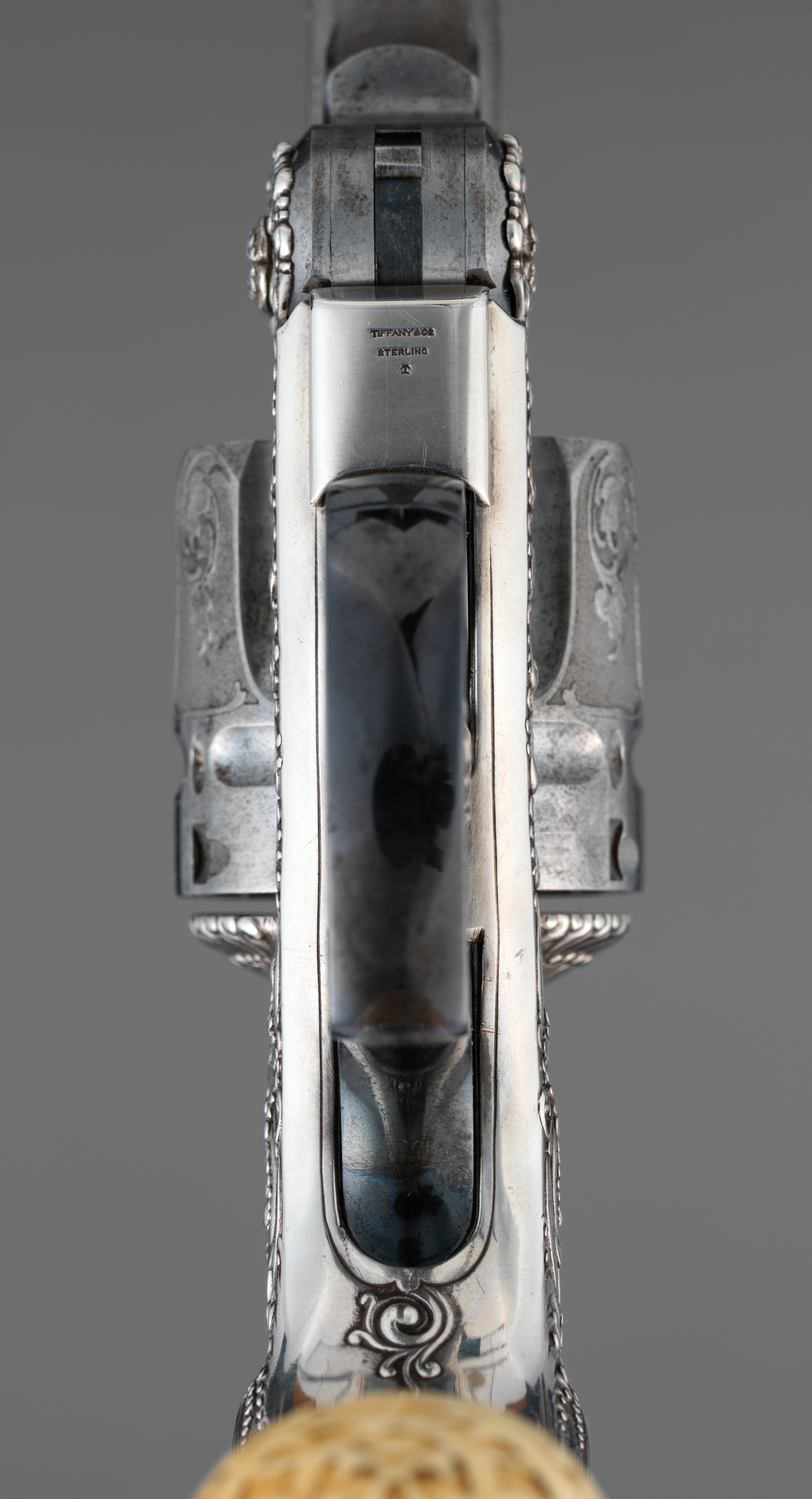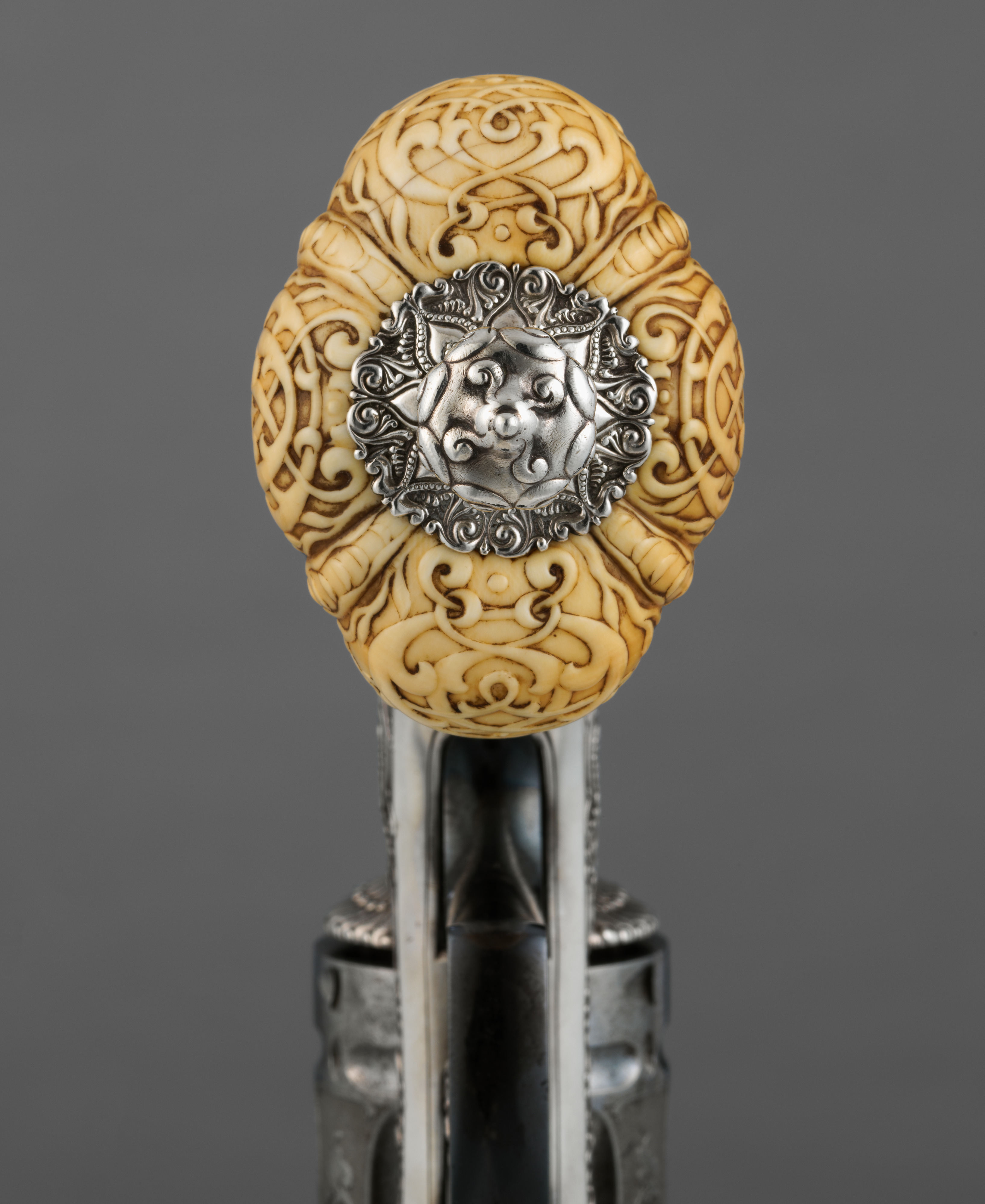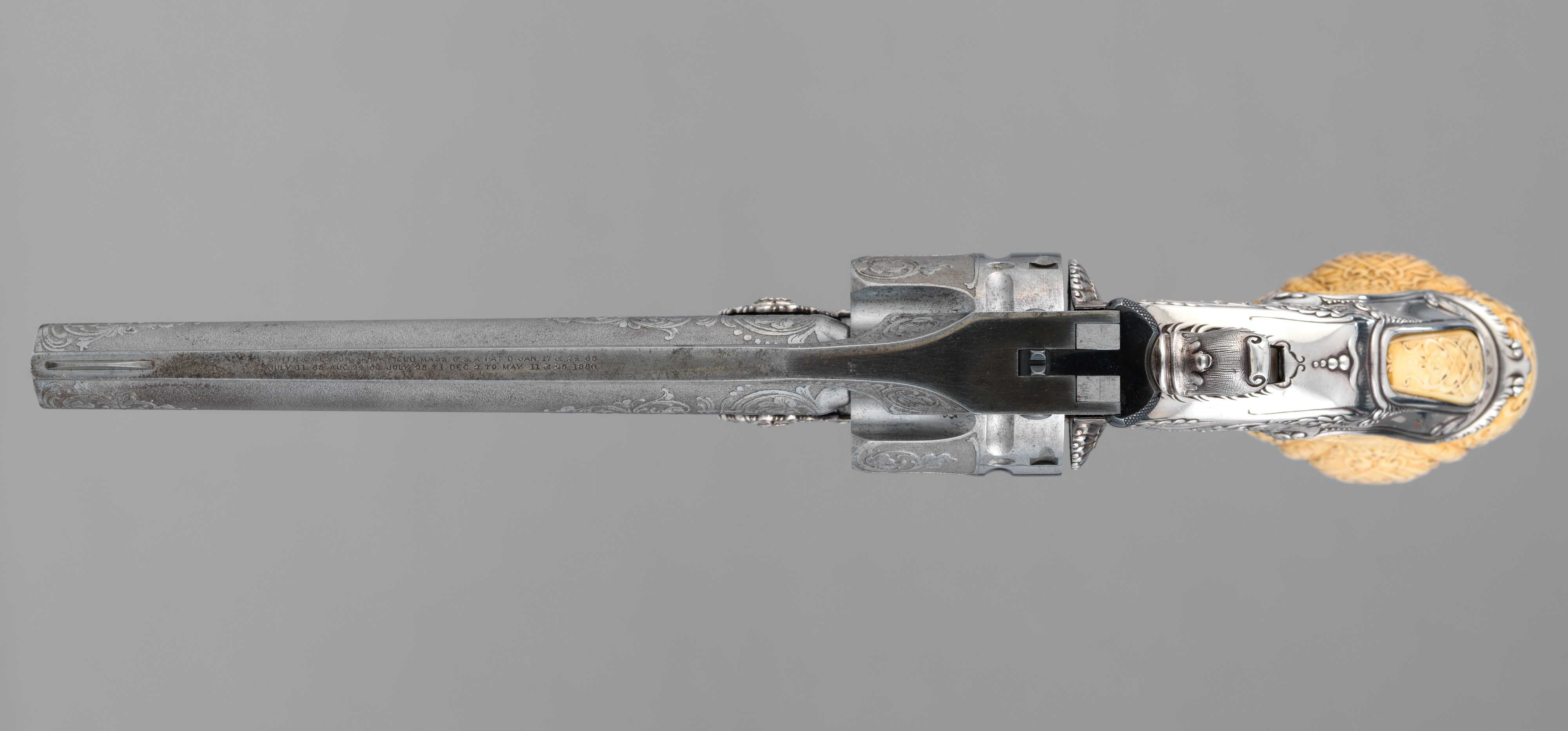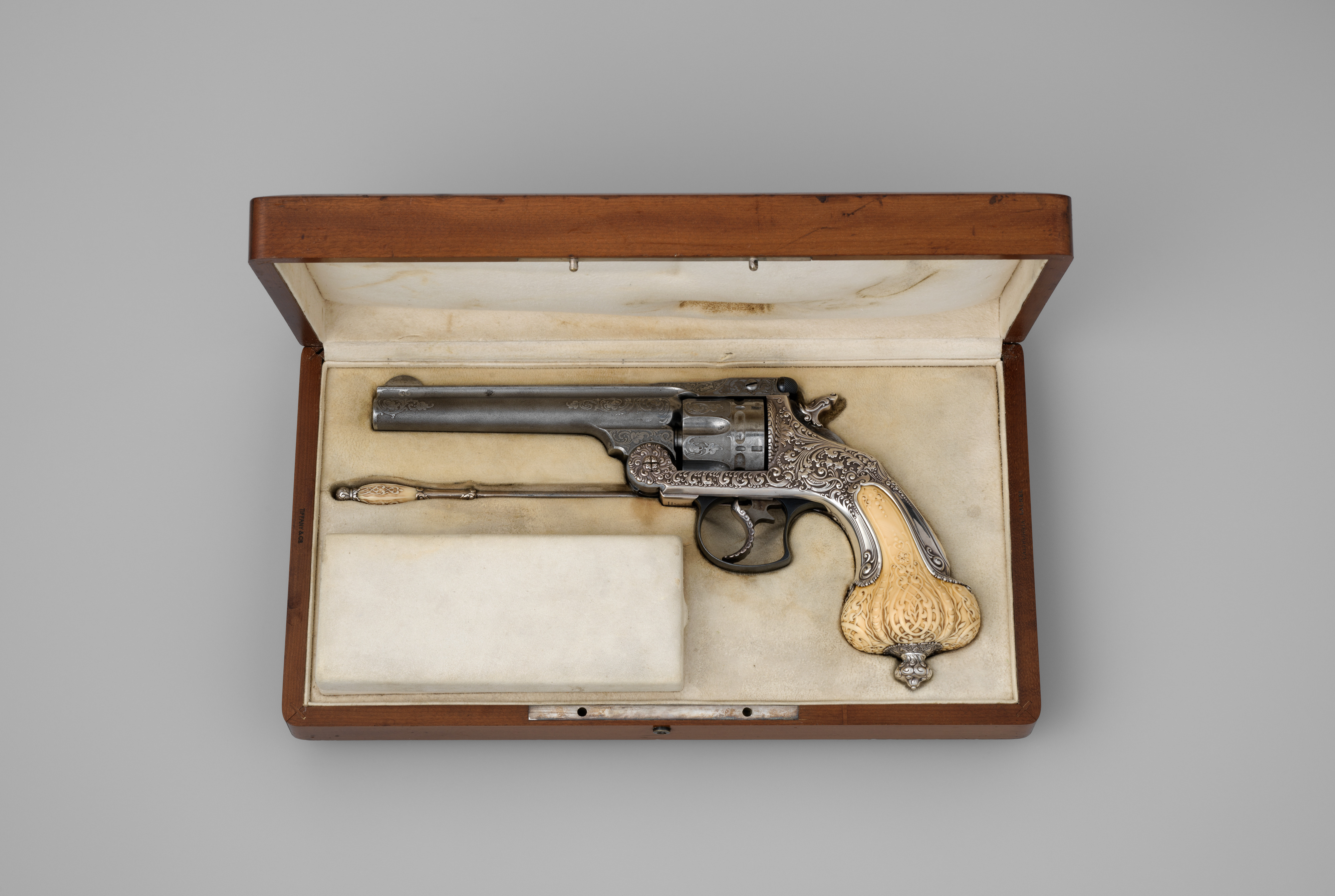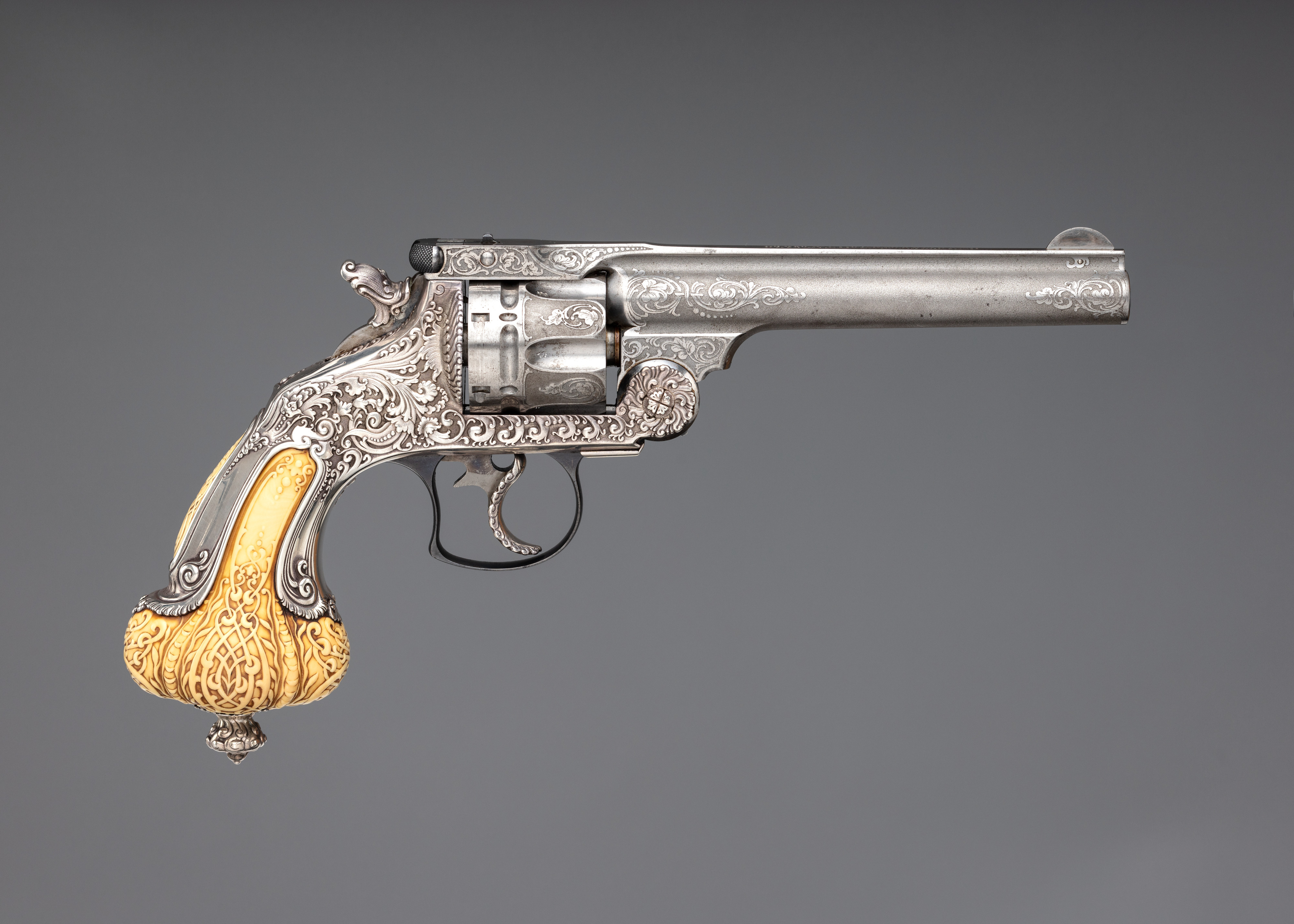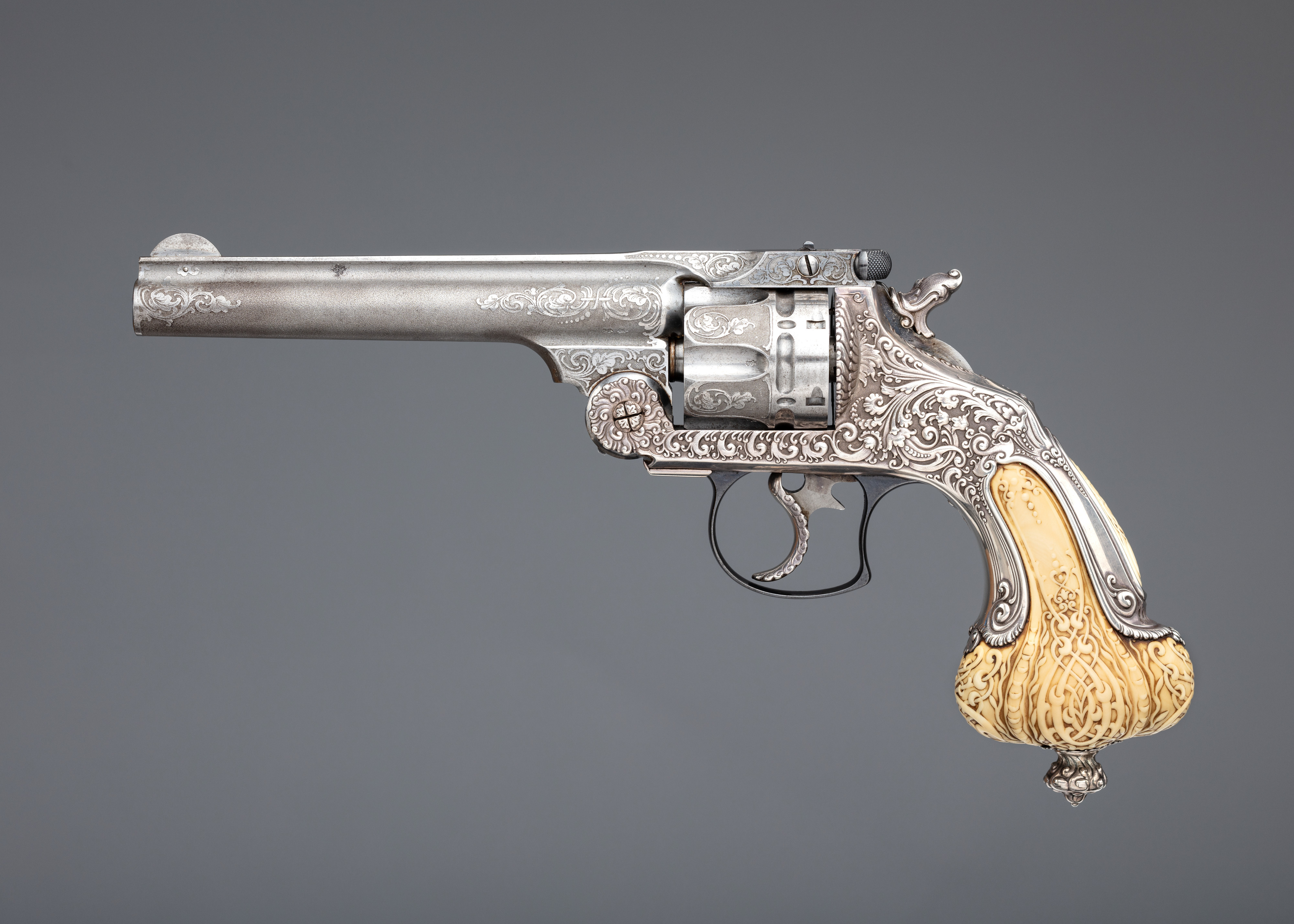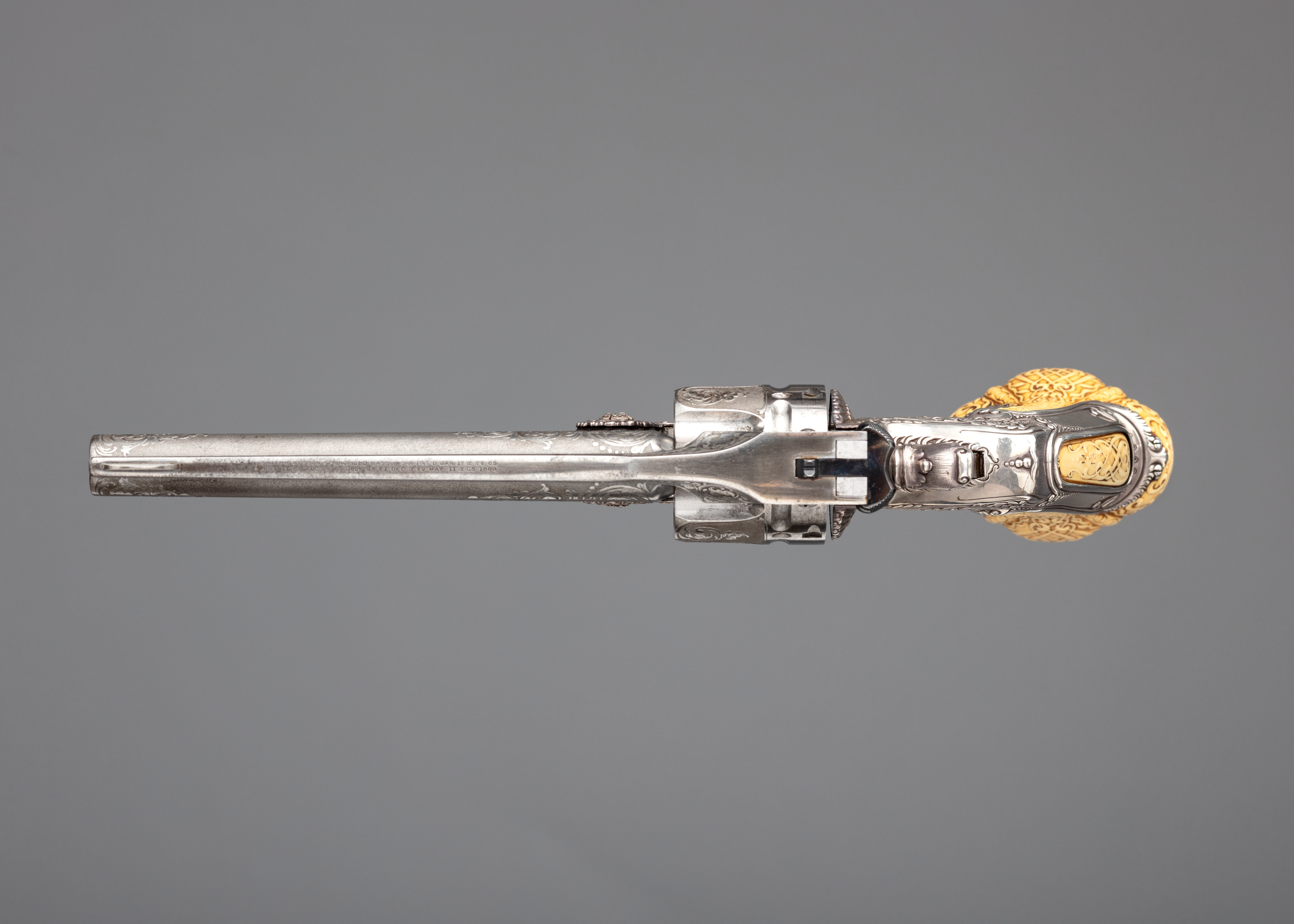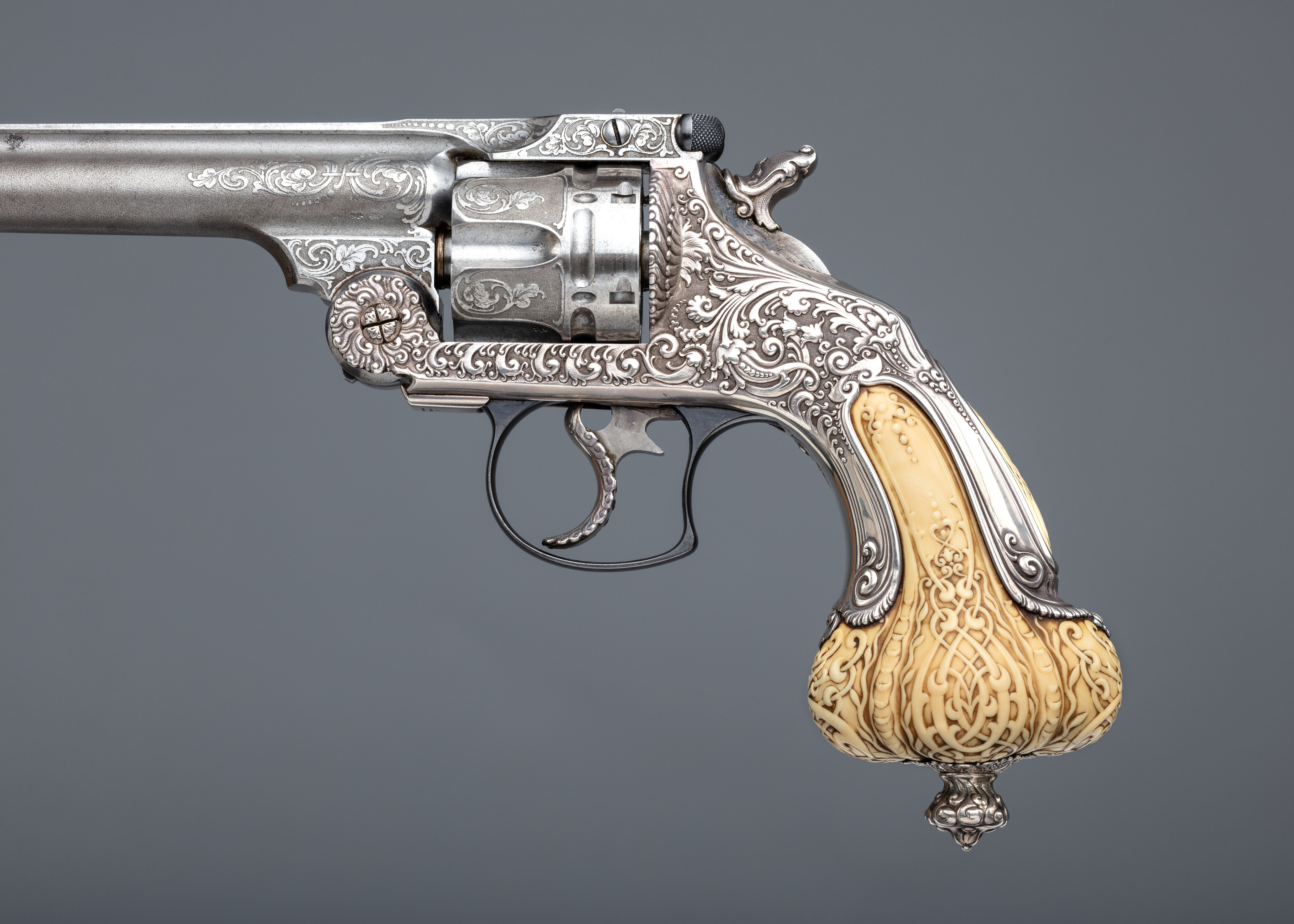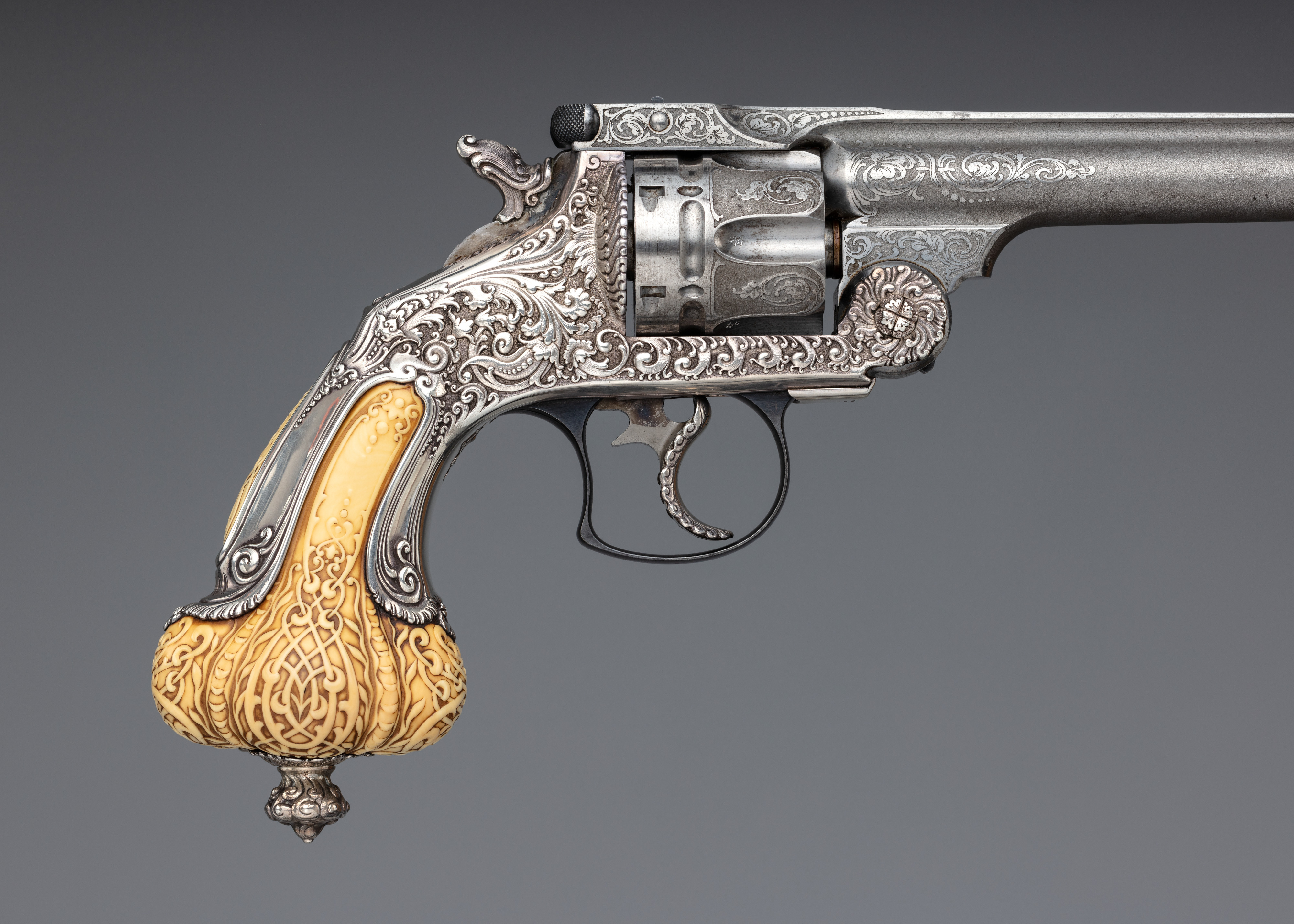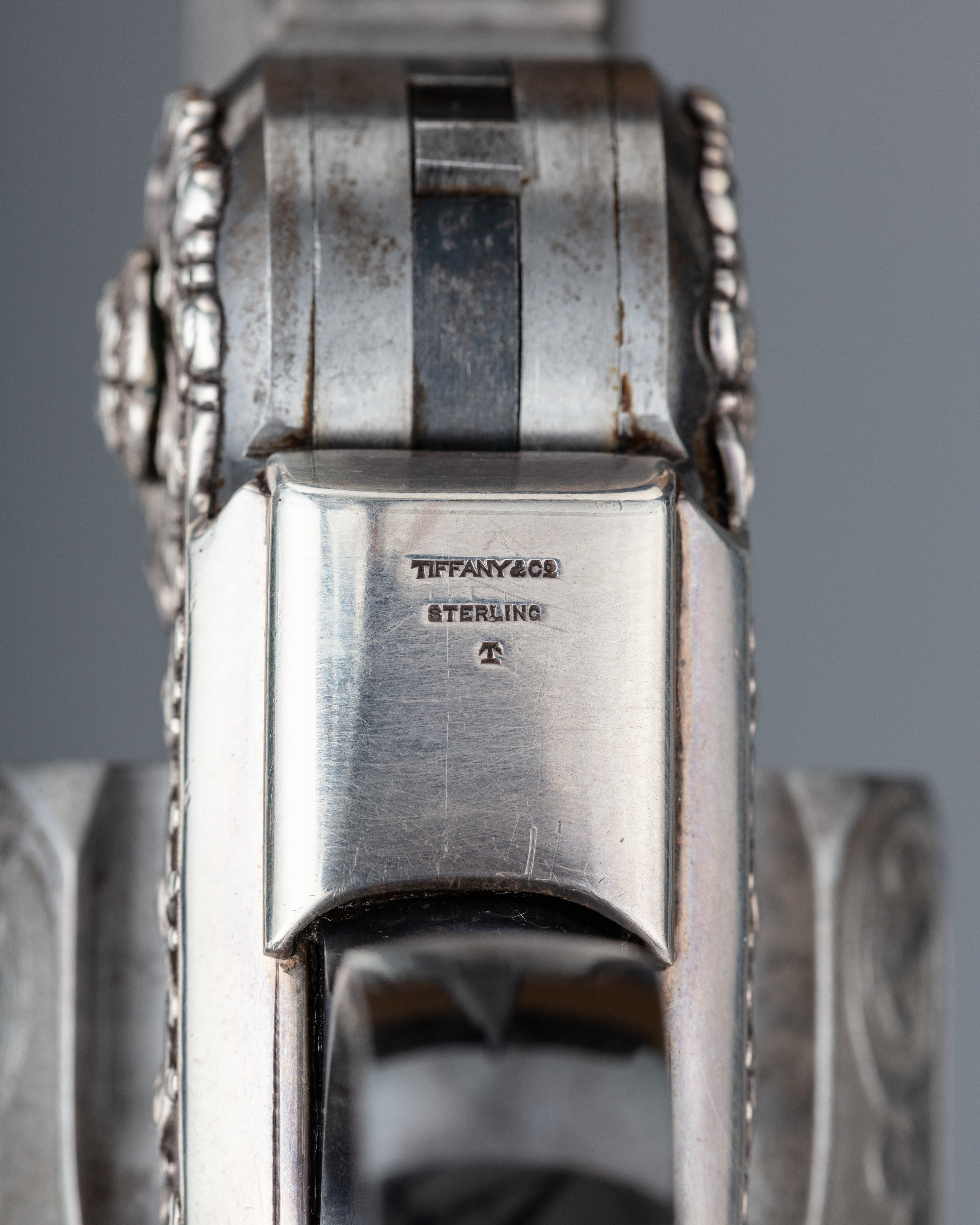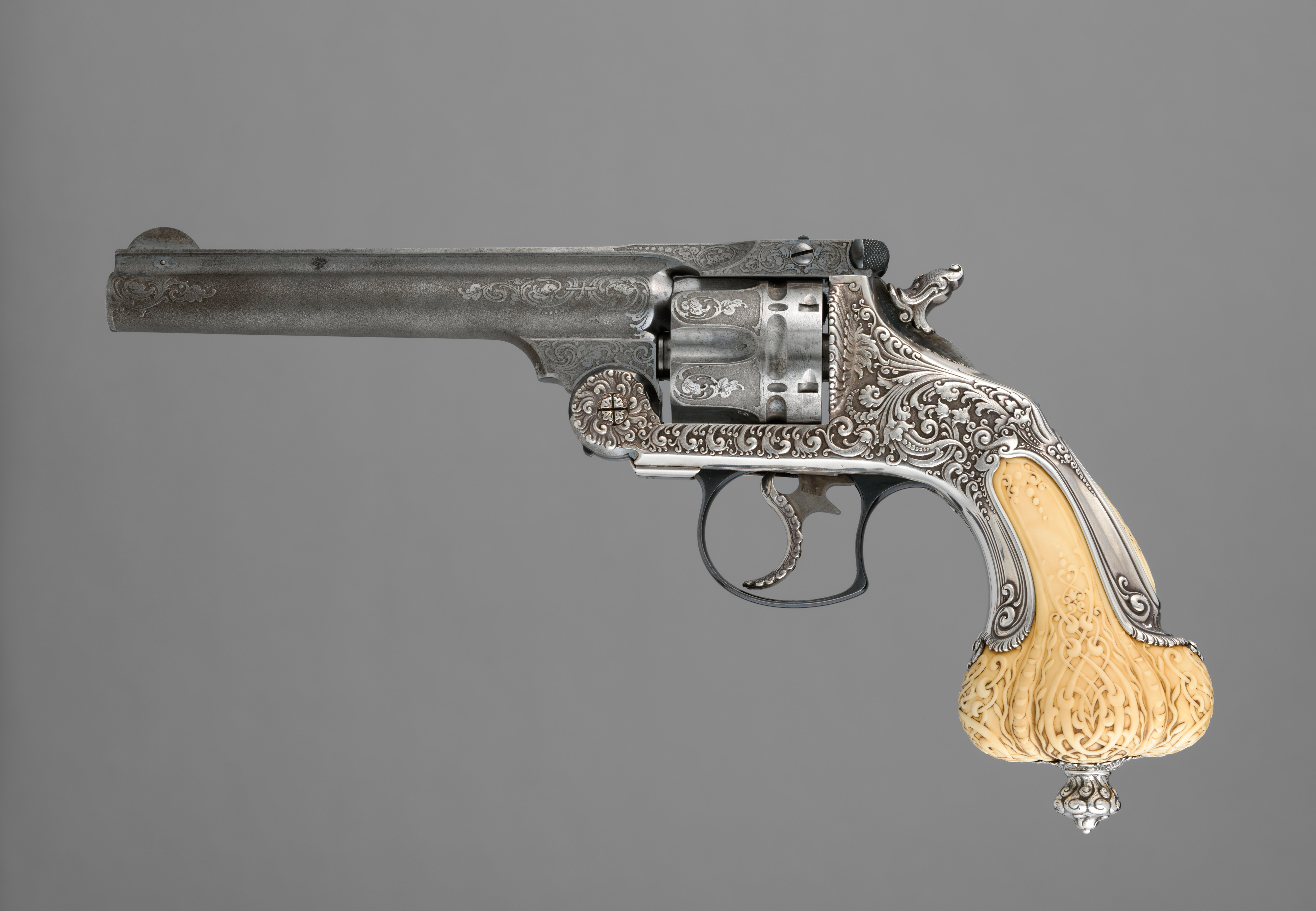Smith & Wesson .44 Double-Action Frontier Model Revolver decorated by Tiffany & Co. (serial no. 8401), with Case and Cleaning Rod
Manufacturer Smith & Wesson American
Decorator Tiffany & Co.
This revolver is exceptional as one of the most elaborate Tiffany-decorated firearms of the late nineteenth century. Made for Smith & Wesson’s display at the World’s Columbian Exposition in Chicago in 1893, the pistol stands as an unrivaled example of the silver firm’s distinct contribution to the decoration of American firearms. This transformative gift to The Met from the Robert M. Lee Foundation not only deepens the Museum’s holdings of Tiffany-decorated guns, as a masterpiece in its category it expands The Met’s ability to tell stories about design in America during the late nineteenth century and to explore the intersections between fine art, industry, engineering, and weaponry.
The revolver marks a peak in Tiffany’s tradition of selling decorated weapons, which by 1893 had been a staple of the firm’s product offerings for nearly fifty years. Tiffany had played a leading role in the design and sale of decorated weapons in the United States since the 1840s. During and after the Mexican War (1846–48) and in the wake of the Civil War (1861–65), the firm was the foremost American supplier of presentation swords, and beginning in the early 1860s it initiated partnerships with the American firearms manufacturers Colt, Derringer, and Smith & Wesson, becoming a major pistol retailer.
Archival evidence suggests that Tiffany decorated handguns in the 1860s and 1870s, but no Tiffany-marked firearm from this period is known and many may have been sold unmarked, with their factory finishes. The firm further expanded its firearms offerings in the 1880s, collaborating with Smith & Wesson and other makers to sell pistols customized with elaborately decorated grips made of silver and other precious materials. Intended for wealthy customers and for promoting the firm's creativity and know-how at international exhibitions, the finest examples rank among Tiffany’s most accomplished works of the 1880s–90s and reflect key styles established by the firm’s lead designer, Edward C. Moore (1827–1891), including the Saracenic and Japaneseque. The eight Tiffany pistols in The Met’s collection together express the great range of materials, techniques, and artistic inspirations employed by Tiffany’s designers under Moore and soon after his death (acc. nos. 2003.546.1; 2003.546.2; 2007.477; 2010.482; 2013.902, 2013.903a, b; 2013.904a–c; 2019.444a–c). They also capture the prestige of American firearms in the late nineteenth century, which were lauded domestically and overseas for their fine engineering and exceptional quality and recognized as exemplars of America’s industrial might.
At the World’s Columbian Exposition in Chicago in 1893, Tiffany & Co. promoted its work with leading American firearms manufacturers Smith & Wesson and Winchester. Its display featured two Winchester rifles and a suite of nine Smith & Wesson revolvers, each uniquely decorated with silver or iron mounts. Three are preserved in The Met’s collection: acc. nos. 2010.482; 2013.902; 2013.903a, b. For display in Smith & Wesson’s booth Tiffany decorated an additional ten revolvers, some with grips incorporating embossed leather and carved wood.
This pistol was a centerpiece of Smith & Wesson’s exhibit, showcased inside of its chamois-lined case in the middle of the company’s primary vitrine. Superlative among the group of revolvers Tiffany decorated for Smith & Wesson’s display, its image was used in Smith & Wesson’s printed promotions. The company featured it on the cover of their Fair catalogue (Description and Prices of Finely Decorated Revolvers Prepared for World’s Fair, —At Chicago, 1893), in which it is listed for sale for $425, making it the costliest Tiffany pistol in Smith & Wesson’s exhibit. Smith & Wesson also pictured the revolver in an advertisement in The Youth’s Companion, where its decoration is described as being of "Ancient Moorish design" (The Youth’s Companion, World’s Fair, Extra Number, Boston, May 4, 1893, in advertisement on cover).
Comprehensively adorned, its grip, trigger, and hammer are encased with sterling silver mounts embossed and chased with profuse floral motifs, with a large piece of ivory delicately carved in the Saracenic style forming the butt. The barrel and cylinder are etched to match. The pistol retains its case and cleaning rod.
Tiffany’s elaborate silver pistol grips represented a groundbreaking new direction for American firearms decoration, departing from the well-established tradition of embellishing guns by engraving and inlaying directly into their steel surfaces (see for example acc. nos. 2018.856.1; 2018.856.2a–o). Tiffany pistols’ construction thus warrants explanation. Following the delivery of a pistol from Smith & Wesson’s Springfield factory to Tiffany’s New York studio, Tiffany craftsmen removed the pistol’s hard rubber grip, filed down the steel frame beneath, and replaced the grip with a "sleeve" of sculpted metal, usually of silver and often incorporating other materials. Tiffany craftsmen etched and silvered the cylinder and barrel en suite on the most luxurious commissions.
This novel approach enabled designers to radically transform the shape and materials of a gun by essentially building a miniature sculpture around it. The firearm remained perfectly functional, although the ornamentation did not improve its ergonomics. The tension between Tiffany’s handmade decorative mounts and Smith & Wesson's finely engineered machine-made components no doubt appealed to the firm’s wealthy customers.
Adding to this revolver’s interest, soon after the Exposition’s closing Smith & Wesson presented it as a gift to Walter W. Winans (1852–1920), the celebrated American collector, author, artist, Olympian, and champion marksman.
Smith & Wesson described the motivation for the gift in a personal letter to Winans dated December 6, 1893:
"…It will give us great pleasure if you will accept this arm with our compliments as a token of our admiration for your skill with the revolver and also as a slight return for services rendered us by the prominence which your splendid record at the target has given to our name and work. We feel that we are indebted to you in no slight degree for the manner in which you have demonstrated the ability of the Smith & Wesson revolver to more than hold its own against all comers and shall be pleased if you allow us to express our appreciation in this way."
Winans subsequently illustrated the revolver in the 1911 edition of his book The Art of Revolver Shooting, describing it as "the most ornamental revolver I have ever seen" (p. 23).
Due to rights restrictions, this image cannot be enlarged, viewed at full screen, or downloaded.
This artwork is meant to be viewed from right to left. Scroll left to view more.


